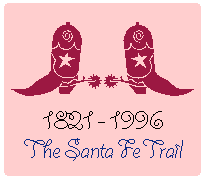According to Dr. Robert R. White, an art historian, much of the earlier work "was done from the standpoint of the ethnologist, scientist, soldier or reporter. The purpose of the art, in the days before practical photography, was to accurately depict what the artist saw."
A few early artists were frontier wives who taught art to children and produced work of their own. Still others drew and painted simply because they wished to do so. The surviving works are treasured for their historical content as well as for their contribution to fine art.
It should be mentioned that much of the artwork portraying the Santa Fe Trail was, like many of the written reports, highly conjectural. The romantic imagination ran unchecked by first-hand observation. Illustrations of an idyllic nature appeared in Eastern periodicals, as did descriptions of perfectly level terrain, moderate weather and friendly inhabitants. Painters emphasized the picturesque, which was easy to do in the comfort of the studio. The same is true to a lesser extent of the art of later years, after rail travel was established and the Santa Fe Trail ceased to be a primary route. These paintings are, however, enlightening as to the public consciousness of the time, and are beautiful to behold as well.
This year, at the one hundred seventy-fifth anniversary of the opening of the Santa Fe Trail, we know better. History has proven that the earliest travellers suffered many hardships. It all began when William Becknell, a trader, left from Franklin, Missouri on September 1, 1821 and fetched up in Santa Fe in mid-November without having planned to do so. His intention had been to trade with the Indians in Colorado, but his timing was unlucky so, instead, he turned toward New Mexico and made history for having established the Santa Fe Trail. He also made a handsome profit dealing with the townspeople, for Mexico had just won its independence and the Spanish silver dollars were flowing freely. The next year, he brought the first wagon caravan from Missouri and established the more direct Cimarron cutoff, running into arid and dangerous conditions along the way.
Thereafter, travellers were able to proceed with more confidence of finding water and getting through the mountains. In 1846, John Mix Stanley joined a trading expedition over the Trail, arriving shortly after General Kearney's Army of the West had conquered New Mexico for the United States. Stanley was promptly hired on as the military expedition's artist in Santa Fe, where he proceeded to chronicle the newly-won territory in a series of charming pictures that demonstrated good composition and drawing skills. He later accompanied the army as it went farther into the West toward California.
Vincent Colyer was a well-known New York artist when he rode the Santa Fe Trail in 1869 and again in 1871. He was an Associate of the National Academy who enjoyed a successful career. Ironically, his paintings are not remembered nearly as well as the watercolors and drawings he did on the Western trips — and he was not even travelling for that purpose. A devoutly religious man, he was on a mission to the Apaches to furnish them with food, clothing, medical supplies, Bibles and other books, under the auspices of the Board of Indian Commissioners. His was a tour of inspection, not an expedition, so he left and rejoined the Santa Fe Trail several times on his journeys. Dr. White observes in Artists of Territorial New Mexico, 1846-1912 that "Apparently, every night wherever he stopped, he did a watercolor of the landscape or vignettes of the people around him. He did these for his own amusement, never intending to have them exhibited."
On his second excursion, Colyer returned to the territorial capital as a presidential envoy assigned to look into the Camp Grant Massacre in Arizona. He took the train part way, then travelled the Santa Fe trail from Kansas westward. His compassion for the Indians made him a controversial character and earned him some bad press, but today he is known for making a start toward a peaceful solution to the animosities between the Indians and the Anglo and Spanish colonists. In fact, it was he who designated the Tularosa Valley as the present Apache reservation, after considering and rejecting other locations that would not afford good farming. He established the reservation system that is still in use all over the Southwest.
Through it all, he observed and painted. His hundreds of watercolors and drawings, sometimes carefully composed and finished and sometimes quickly sketched, survive in several large collections which were auctioned in the mid-twentieth century, and in numerous individual pieces in smaller public and private collections.
Other artists, including Frederick Remington, waited until the railroad was completed in 1880 to travel to New Mexico. At that point, the Santa Fe Trail became history. We would never know what it really looked like if it were not for those robust artists who endured the danger and discomfort of those days, and who set down their impressions in ink and watercolor for all time.
Historical Context
1821 Mexican Independence; William Becknell opens Trail
1827 Fort Leavenworth, KS opens
1829 Military escorts begin
1833 Bent's Fort, CO established
1836 Texas declares independence
1840 Mexican War
1849 California Gold Rush
1851 Fort Union, NM opens
1859 Colorado Gold Rush
1862 Glorieta Pass, NM Civil War battle
1864 Indian attacks; Sand Creek Massacre
1865 Fort Dodge, KS opens
1880 Railroad reaches Santa Fe
1987 Santa Fe National Historic Trail established
1996 175th Anniversary celebrations
|

